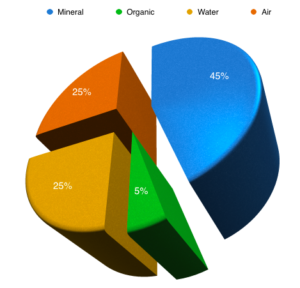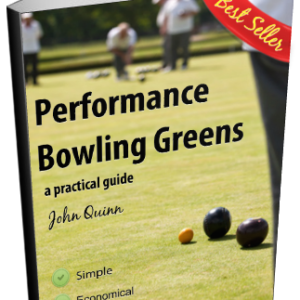
The Sub-Surface Requirements for a High Performance Bowls Green are pretty much set in stone. Get these right and you’re well on your way to a Performance Bowling Green.
First of all then, have a look at the diagram above. This represents the ideal make up of a performance bowls green’s rootzone.
Do you see anything remarkable?
Well, when I explain this to my clients for the first time, many of them are surprised to say the least.
If you look closely at the diagram you will see that the ideal green will be 50% nothing; yes space, just air cavities within the soil. Now, of course I am not going to tell you to get rid of half your green to achieve this, but next week I am going to share with you a program whereby you can get close to this ideal situation of ½ solids and ½ space in your green.
Of course the space isn’t just nothing; half of the space consists of “micro-pores” and half is “macro-pores”. Put simply the micro-pores contain water and the macro-pores contain air. This is very important to understand and is one of the least understood concepts within sportsturf maintenance.
The “nothing” element of the ideal green is the most important factor to get right, because this is where we get the balance between speedy drainage and good growing conditions and it is due to a fundamental misunderstanding of this concept that a very large number of UK bowling greens are in poor condition and can’t be prepared for performance consistently. The only saving grace for these greens is that the UK summer is also very inconsistent and sometimes acts in their favour; so that we occasionally get a very good season’s bowling when the “green has never been better”. This is a false reading in most cases and the problem is exacerbated by the club attributing this success to the latest fad program.
The green which has a well balanced soil as described and illustrated above will naturally:
- sustain a firm, fast surface with a minimal input maintenance program
- sustain a healthy sward of fine grasses
- sustain a high, year-round population of soil microbes
- provide a natural cycle of nutrient release from soil organisms and micro-organisms (microbes) working on fresh organic matter (thatch).
- resist compaction and therefore resist:
- shallow rooting
- annual meadow grass ingress
- flooding and puddling
- head skinning
- retain the optimum amount of soil water for healthy growth with minimum requirement for artificial irrigation.
- drain reasonably quickly after excessive rainfall.
- retain the optimum amount of plant available nutrition
- sustain a soil pH within the optimum range for fine turf
- resist attack from fungal diseases
- resist the onset of Localised Dry Patch and other soil and turf disorders
- maintain a tight, dense sward with an upright growth habit which will reduce ingress of moss, weeds and weed grasses.
- resist localised settlement and bumpiness due to excessive thatch and erratic thatch decomposition
Comprehensive action plan for achieving the above included in the book below. It costs less than a bag of cheap fertiliser.

